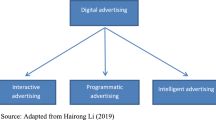Abstract
There are two methods for mobile advertising: SMS and broadband advertisement. Previously SMS is the most common way of mobile advertising. Previous researches on consumer acceptance have been focused on SMS advertisement. This paper aims to identify factors that influence consumer’s intention to accept mobile broadband services with add-on advertising. As theory of reasoned action (TRA) has been widely used to explain user behavioral intension in previous researches, we proposed extended TRA by including six factors for testing adoption of mobile broadband services with add-on advertising: Perceived Value, Contextual Awareness, Trust, Solidarity, Familiarity and Effect. The proposed model has been tested on selected Thai mobile broadband user communities. The results from 61 valid responses during 2 weeks time period found that attitude toward mobile advertising and subjective norms have weak significance on user intention to accept add-on advertising. It is also found that Perceived value has higher significant than other proposed factors. With the proposed model, it is possible for advertisers to create an effective and pertinent mobile broadband advertising.




Similar content being viewed by others
References
ITU (2012). Key statistical highlights: ITU data release June 2012.
Alison Fennah, D. K. (2011). Global Mobile Advertising Spend 2011. New York: Interactive Advertising Bureau (IAB).
Bauer, Hans H., Barnes, Stuart J., & Reichardt, Tina. (2005). Driving consumer acceptance of mobile marketing: A theoretical framework and empirical study. Journal of Electronic Commerce Research, 06(03), 181–192.
Fishbein, M., & Azjen, I. (1975). Belief, attitude, intention and behavior: An introduction to theory and research. Reading: Addison-Wesley.
MMA (2012). Mobile Marketing Industry Glossary. http://www.mmaglobal.com/uploads/glossary.pdf. Accessed 12/08/2012 2012
Davis, F. D. (1989). Perceived usefulness, perceived ease of use, and user acceptance of information technology. MIS Q., 13(3), 319–340. doi:10.2307/249008.
Viswanath Venkatesh, M. G. M., Davis, Gordon B., & Davis, Fred D. (2003). User acceptance of information technology: Toward a unified view. MIS Quarterly, 27(3), 425–475.
Rajala, R., & Westerlund, M. (2010). Antecedents to Consumers’ Acceptance of Mobile Advertisements—A Hierarchical Construct PLS Structural Equation Model. In System Sciences (HICSS), 2010 43rd Hawaii international conference on, 5–8 Jan. 2010 2010 (pp. 1–10). doi:10.1109/hicss.2010.64.
Trongmateerut, P., & Sweeney, J. T. (2012). The Influence of Subjective Norms on Whistle-Blowing: A Cross-Cultural Investigation. Journal of Business Ethics. doi:10.1007/s10551-012-1270-1.
Sathapornvajana, S., & Watanapa, B. (2012). Factors affecting student’s intention to choose IT program. Procedia Computer Science, 13, 60–67. doi:10.1016/j.procs.2012.09.114.
Chooprayoon, V., Chun Che, F., & Depickere, A. A. (2007). TECTAM, A modified technology acceptance model to assess E-commerce technologies adoption by Thai SME. In TENCON 2007–2007 IEEE Region 10 Conference, Oct. 30–Nov. 2 2007 (pp. 1–4). doi:10.1109/tencon.2007.4428977.
Premchaiswadi, W., Porouhan, P., & Premchaiswadi, N. (2012). An empirical study of the key success factors to adopt e-learning in Thailand. In Information Society (i-Society), 2012 International Conference on, 25–28 June 2012 (pp. 333–338).
Boontarig, W., Chutimaskul, W., Chongsuphajaisiddhi, V., & Papasratorn, B. (2012). Factors influencing the Thai elderly intention to use smartphone for e-Health services. In Humanities, Science and Engineering Research (SHUSER), 2012 IEEE Symposium on, 24–27 June 2012 (pp. 479–483). doi:10.1109/shuser.2012.6268881.
Kijsanayotin, B., Pannarunothai, S., & Speedie, S. M. (2009). Factors influencing health information technology adoption in Thailand’s community health centers: Applying the UTAUT model. International Journal of Medical Informatics, 78(6), 404–416. doi:10.1016/j.ijmedinf.2008.12.005.
Merisavo, M., Kajalo, S., Karjaluoto, H., Virtanen, V., Salmenkivi, S., Raulas, M. et al. (2007). An empirical study of the drivers of consumer acceptance of mobile advertising. Journal of Interactive Advertising, 7(2), 41–50
Malhotra, N. K., Kim, S. S., & Agarwal, J. (2004). Internet users’ information privacy concerns (IUIPC): The construct, the scale, and a causal model. Information Systems Research, 15(4), 336–355. doi:10.1287/isre.1040.0032.
Okazaki, S., Molina, F. J., & Hirose, M. (2012). Mobile advertising avoidance: exploring the role of ubiquity. Electronic Markets, 22(3), 169–183. doi:10.1007/s12525-012-0087-1.
Xiao, S. (2011). Consumer adoption of mobile advertising: An empirical investigation among China users. In Product innovation management (ICPIM), 2011 6th international conference on, 16–17 July 2011 (pp. 461–464). doi:10.1109/icpim.2011.5983702.
Ajzen, I. (1991). The theory of planned behavior. Organizational Behavior and Human Decision Processes, 50(2), 179–211.
Drossos, D., Giaglis, G., Lekakos, G., Kokkinaki, F., & Stavraki, M. (2007). Determinants of effective SMS advertising: An experimental study. doi:citeulike-article-id:1460118.
Leppaniemi, M., & Karjaluoto, H. (2005). Factors influencing consumers’s willingness to accept mobile advertising: A conceptual model. International Journal of Mobile Communication, 3(3), 197–213. doi:10.1504/ijmc.2005.006580.
Chen, P.-T., & Hsieh, H.-P. (2012). Personalized mobile advertising: Its key attributes, trends, and social impact. Technological Forecasting and Social Change, 79(3), 543–557. doi:10.1016/j.techfore.2011.08.011.
McCrickard, D. S., Czerwinski, M., & Bartram, L. (2003). Introduction: Design and evaluation of notification user interfaces. International Journal of Human-Computer Studies, 58(5), 509–514. doi:10.1016/s1071-5819(03)00025-9.
Yan, Z., Liu, C., Niemi, V., & Yu, G. (2010). Effects of displaying trust information on mobile application usage. In Paper presented at the proceedings of the 7th international conference on autonomic and trusted computing, Xi’an, China.
Cassell, J., & Bickmore, T. (2003). Negotiated collusion: Modeling social language and its relationship effects in intelligent agents. User Modeling and User-Adapted Interaction, 13(1), 89–132. doi:10.1023/a:1024026532471.
Sweeney, J. C., & Soutar, G. N. (2001). Consumer perceived value: The development of a multiple item scale. Journal of Retailing, 77(2), 203–220. doi:10.1016/s0022-4359(01)00041-0.
Acknowledgments
The author acknowledges reviewers for their review and for all valuable comments that improved the paper. We also thank the editor of this journal for valuable suggestions.
Author information
Authors and Affiliations
Corresponding author
Rights and permissions
About this article
Cite this article
Srisawatsakul, C., Papasratorn, B. Factors Affecting Consumer Acceptance Mobile Broadband Services with Add-on Advertising: Thailand Case Study. Wireless Pers Commun 69, 1055–1065 (2013). https://doi.org/10.1007/s11277-013-1065-4
Published:
Issue Date:
DOI: https://doi.org/10.1007/s11277-013-1065-4




